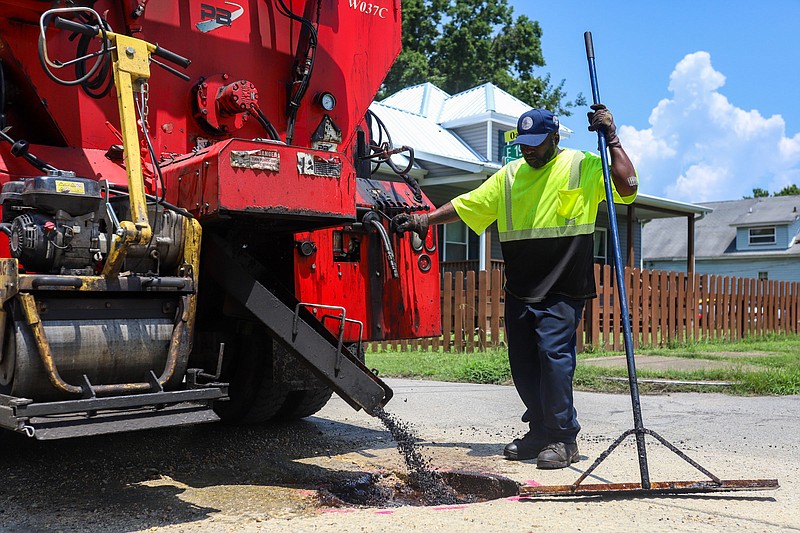City 26th worst in country
Chattanooga had such a reputation for potholes that now-Mayor Tim Kelly spent a chunk of his 2021 campaign cash on television advertising showing him filling local potholes.
In June, the mayor's staff announced that the city had had filled 90% of potholes that had been identified on city streets since his election.
In spite of that proclamation, almost everyone would be able to tell the Kelly administration of a pothole they encounter daily, if they'd only take the time to do so.
Kelly, in his campaign, committed to the city spending $40 million in road repairs over four years, a significant increase from the last decade.
"Transportation is critical to getting to work, going to school and engaging with our outdoor assets, which is why we've placed a healthy emphasis on addressing our city's aging infrastructure," the mayor said in a June 28 news release. "After all, if residents can't trust their local government to take care of potholes, then why would they trust it to address housing, gun violence and job creation?"
A presentation the administration made to the Chattanooga City Council a year ago indicated the proportion of city roads rated in excellent condition had decreased from 49% in 2010 to 19% in 2020. The number of road rated in poor condition jumped from 7% to 20% over the same period.
The city's roads reputation may be one reason a new survey by Quote Wizard, using Google search statistics, rated Chattanooga's pothole problems the 26th worst in the country.
The worst in the country? That would be Nashville, whose infrastructure evidently has not kept up with its rapid growth.
Tennessee, whose road quality was rated the best in the country in 2022 by WalletHub, was listed as ninth worst in the country for potholes by the survey and the worst in the South.
Michigan, according to Quote Wizard, has the worst pothole problem in the country.
Higher gas prices? Who cares!
The reason the state's pothole problem may be on the rise could be that Volunteer State drivers keep on driving, despite the record high gas prices that have plagued the country over the past year.
Across the country, the high gas prices led to a decrease of 10,500,000 fewer gallons of gas daily in October than in October 2021, according to Quote Wizard.
In some states, gasoline demand fell as much as 20%, but seven states had an increase in daily gallon consumption. Tennessee was one of those.
While we were nowhere near North Dakota's increased daily usage of 32%, we are up 2% over a year ago. That's slightly less than the 6% increase in Florida and the 3% increases in Alabama and Kentucky but more than than the 1% increases in Illinois and New Mexico.
The survey also measured gallons used per driver and gallons used per person over the past six months.
Tennessee is the 16th most populous state, but it used the 11th most gallons per driver (332) over the period and the 13th most gallons per person (234).
According to the survey, expansive Montana was easily the leader in most gallons per driver (411) and gallons per person (314), while Pennsylvania used the fewest gallons per driver (181) and tied with New York with the fewest gallons per person (124).
On the food front
The inflation raging across the country is also sending Tennesseans to seek federal help with food for their families, according to the U.S. Department of Agriculture.
While the number of people in the state receiving food stamps (EBT cards) reached its lowest level since 2003 in August, the numbers climbed back up in September and October with inflation and the end of COVID-related money, which helped fuel families in 2020 and 2021.
In August, 786,502 Tennesseans were receiving federal food assistance, or about 10.9% of state residents. That number climbed to 806,910 in September, then fell to 793,968 in October.
The number of state households requiring food assistance took a similar course. Its August mark was the lowest since 2007, but it climbed again in September before falling back slightly in October.
The per-person monthly cost for food assistance in Tennessee, which had risen to $336.18 during the pandemic in August 2021, fell to $117.88 in August 2022.
In Hamilton County, the number of people enrolled in the federal food program increased slightly from 38,686 in August to 39,603 in September and dropped back to 38,794 for October. But the amount flowing into the county for food assistance rose more than $1 million in the last month, going from $6,835,045 in September to $7,878,086 in October.
The number of people in the county enrolled in the program going forward and the amount of money issued to residents will be a good indication of how much worse the economy is getting.
Tennessee has managed to fare better than most states over the past couple of years, but a poor national economy is likely to take its toll.
